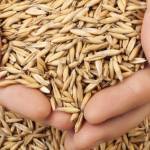Oats in the Equine Diet

Modern horsemen, as well as those of yesteryear, love to feed oats and justifiably so. The popularity of oats often stems from mere habit or tradition, but other reasons include a relatively high margin of safety, willingness of most horses to devour them, and perhaps most prominently, a lack of familiarity with the array of alternative feedstuffs in the marketplace.
But are plain old oats capable of fulfilling the nutrient needs of all horses–of rollicking weanlings and yearlings, lactating matrons, and hard-knocking athletes? No, oats simply do not have the nutritional profile necessary to fulfill the nutrient requirements of many horses. You may be saying to yourself that horses can indeed survive solely on hay and oats and did so for years. This is true, but in those days of yore horses were washed-up, incapable of remaining sound for consistent, hard work, by the time they reached their mid-teens. Vitamin and mineral deficiencies often take their toll slowly and therefore do not surface until much later in life. A fortified feed, one designed carefully to include a balance of protein, vitamins, and minerals, is the surest way to maximize growth and performance.
Oats typically contain 10-12.5% crude protein. While oats are often a main ingredient in fortified feeds, a supplemental source of protein is usually added. Soybean meal is the most common protein supplement used because it has an excellent balance of essential amino acids, including lysine, which is necessary for proper growth. Fortified feeds can be formulated with varying percentages of crude protein, from 10-18%. Fed with grass hay, oats can conceivably provide enough protein for horses at maintenance or horses asked toper form occasional light exercise. However, plain oats contain insufficient lysine for maximal growth of young horses.
Oats and fortified feeds differ in the amount of fiber they bring to the feed bucket. The high fiber content of oats, approximately 11%, makes them relatively safe to feed, with the risk of overfeeding less dangerous than overconsumption of sweet feed. The hull of the oat contains the majority of the fiber. Hull-less oats, on the other hand, have only 2-4% fiber. The fiber fraction of fortified feeds varies according to the major ingredients and can be as low as 5%, when it is a corn-rich concentrate, or as high as 25%, when it is full of beet pulp or when it is a complete feed. The digestibility of the fiber in each meal differs. Fiber in oat hulls is relatively indigestible. Conversely, fibers used in fortified feeds are generally more digestible and are therefore considered sound energy sources for horses.
On the macronutrient front, oats are inherently high in phosphorus (0.35%) and low in calcium (0.05%). Cereal grains, such as oats, contain only one-tenth to one-third of the calcium needed for maximal growth. Feeding oats with a grass hay, as opposed to a calcium-rich legume hay, may skew the calcium to phosphorus ratio. This is especially detrimental to growing horses, as sufficient calcium is necessary for bone formation. Weanlings and yearlings consuming calcium-deficient diets may be at risk of developing rickets, a disease characterized by swollen, malformed joints and crooked bones. Adult horses will suffer from nutritional secondary hyperparathyroidism, also known as big head disease, in which calcium is resorbed from bone and is used to form weak bony deposits on the jaw and bridge of the nose. Mares in late gestation and early lactation fed only oats and pasture or grass hay may resorb calcium from their own skeletons to properly satisfy requirements of fetal ossification. Fortified feeds have added vitamins and minerals that compensate for deficiencies in oats and other cereal grains included in a textured or pelleted feed.
Few qualms ever arise surrounding the palatability of oats. The oat grain has a soft kernel that is easy for horses to chew. In preference trials featuring plain oats and textured feeds, horses favored textured feeds. Much of this may be due to the temptation of sweet-tasting molasses. Eagerness to eat becomes an issue in racing stables and some show stables, such as those involved in halter horse competition. Horses that refuse to clean up their rations can arouse panic in their caretakers because an immediate decrease in performance may result.
A 50-pound bag of a high-quality, well-fortified feed will usually cost more than a 50-pound bag of whole oats. Horsemen should look beyond the dollar and cents of the matter. Cost savings are valuable only if they do not undermine the production, performance, or health of a horse. In instances when alfalfa hay must be fed in order to get the calcium and phosphorus proportion to jibe with that inherent in oats, buying fortified feed may actually be cheaper than purchasing a truckload of legume or legume-mix hay.
Don’t get the wrong idea, though. Plain oats may have a place in the diets of some horses. Mature horses in light work and without the demands of reproduction may do just fine on plain oats, especially if pasture is scarce or low quality or if the forage source is low in energy. If oats are chosen as a way to increase caloric intake, a feed balancer should be used to ensure proper levels of vitamins and minerals are consumed. For horses with increased energy demands, however, plain oats will not deliver sufficient protein, vitamins, and minerals for maximal growth or performance.








